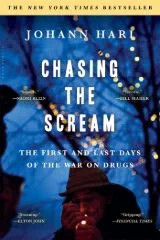Calculus 6th Edition by Jam...
I transferred to a few different schools by t...
By Reanna Quitzon1661

0

Taking pages from Hunter S. Thompson’s gonzo journalism and Mark Twain’s storytelling, Johann Hari’s first book, Chasing the Scream, is a poignant and gripping read from cover to cover. Delving into one of the most controversial topics in modern politics, Johann Hari made sure his scream was heard. Hari’s research and arguments can all be consolidated into one big message: ending the merciless war on drugs.
The book was both criticized and praised by critics, the public, and even scientists. Hari’s take on the war on drugs was relentless in showing not just the political discrepancies, but the capitalistic and political agendas ensuring that the gears of war stay oiled.
Johann’s journalistic instincts drove him to 9 different countries, conducting interviews with addicts, lawmakers, previous Mexican cartel members, police officers, scientists, and more. The book took about 3 years to be written due to the vast amount of research that had to be done on such a close level to forbidden and uncharted territories.
Johan made sure to mention big names highly relevant to the narrative of the drug war in the last 100 years. His focus was on early figures like the musician Billie Holiday, mob boss Arnold Rothstein, and the first commissioner of the Federal Bureau of Narcotics Harry J. Anslinger.
The first half of Chasing the Scream is full of shocking interviews and meetings with sidelined members of the society that were in the first lines of the war on drugs. Recordings of many interviews were made available by Johann online, in addition to over 60 pages of documentation in the form of notes on his sources and interviews.
From a transsexual drug dealer looking for their lost mother to a Mexican gang member looking to escape a life of misery, Johann manages to paint a portrait of the true extent of the radical war on drugs.
Hari used the “Rat Park” studies as a focal point in the narrative to show the major problems associated with addiction and how society stigmatizes it.
The Canadian psychologist Bruce K. Alex designed a series of experiments that tried to further elaborate on his hypothesis that drugs do not cause addictions. The experiment was mentioned at length in the book. The short version was that rats were categorized into 4 groups, and each group lived under different conditions, all exposed to morphine-laced water.
The stressful environment of certain groups made its rats lean towards drinking the morphine water, sometimes to the point of death. The more their environment improved, the more they were avoiding morphine water.
Many critics and other psychologists criticized the nature and results of the experiment, which the book had made even more popular.
The results of the experiment were rejected by Science and Nature, two major academic publishers, but were later on published in Pharmacology Biochemistry and Behavior. Johan’s main approaches to the treatment of addiction and curbing overdoses revolved around the hypotheses that suggested that the surrounding environment in all its stresses was the leading cause of people turning to drugs as a resolution. Many recovering addicts shone in on the topic and reinforced the conclusion of Alexander’s experiments.
Johann went the extra mile to show how the infamous drug cartels of Mexico have been profiteering and gutting the economy by using the war on drugs as their major catalyst. His interviews with different figures in the Mexican drug landscape show that the war on drugs was only causing more damage instead of fixing problems.
Criticisms of Hari’s choice of interviews and perspectives revolved around the fact that he cherry-picked the opinions that supported that drugs weren’t a cause of addiction. Opinions on what drugs do on a physiological and psychological level aside, it’s hard not to blame the war on drugs for the huge number of lives that it has reaped.
A detailed account of the origins of narcotics regulation was given by Johann to help shape a picture of how drugs came to be the taboo the society is most scared of. Harry Anslinger is considered the main facilitator and progenitor of the war on drugs. Harry, a morphine addict at the time, pushed for the outlawing of marijuana using extremely racist propaganda against African Americans.
His racism extended to the jazz musician Billie Holiday, whom he stalked and harassed tirelessly. His newly appointed position as the head of the Federal Bureau of Narcotics, while not very strong in the 1930s, managed to shift the attention from alcohol prohibition to a full-on war on drugs.
Jazz with its freeform style and multiple racial roots was a form of music that opposed what he believed in, which was the main motivation of his relentless endeavors to topple Billie Holiday.
The second half of the book is dedicated to the portrayal of different methodologies that can replace the existing one to combat the negative effect of addiction and drugs. Many notable examples were made on different countries and cities that took on the addiction and overdosing crises under a new light.
Johann was trying to send the message that the mounting of violence in the war on drugs was unnecessary. He believed that the power and influence of cartels and gangs would fall like a house of cards if drugs weren’t prohibited.
All in all, some reservations about the documentation of Hari’s journey still stand. And while the book is a great introduction to the nature and extent of the war on drugs, it may leave a lot to be desired in terms of a variety of opinions.
Johann’s battle with an addiction to narcolepsy drugs has taken him on a journey that he will never forget. The book’s portrayal of the gears of war may help some come closer to understanding the true nature of addiction, even if the book doesn’t get it completely right, according to some critics.
Updated 4 years ago